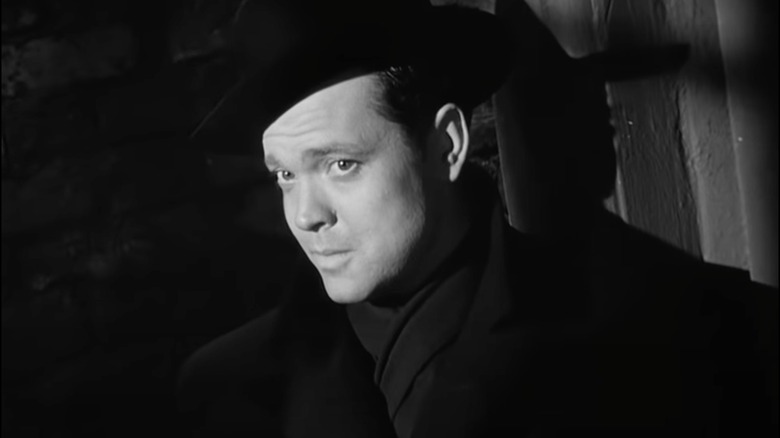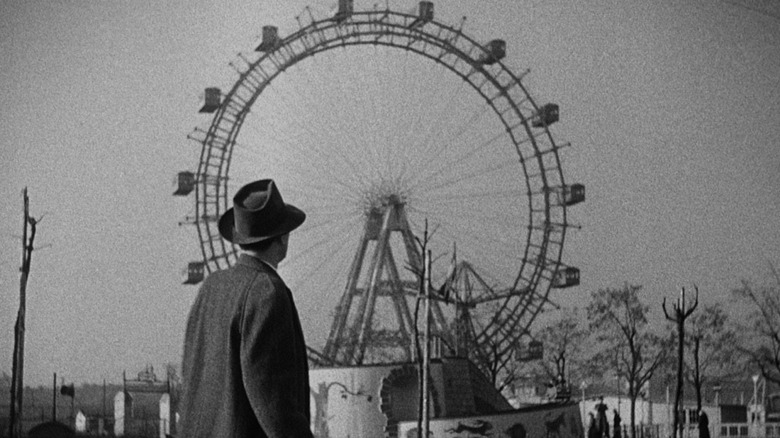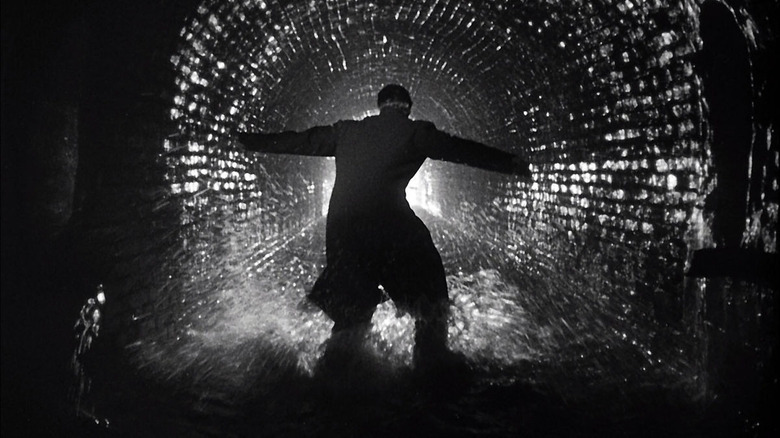Orson Welles Added Some Genius Improv To One Of The Third Man's Most Famous Scenes
Pop quiz — what's the best movie that stars Orson Welles, but that he didn't direct? I'll bet that most of you answered "The Third Man," and rightfully so.
Released in 1949, "The Third Man" is set and filmed in post-World War 2 Vienna. Pulp author Holly Martins (Joseph Cotten) arrives in the city to meet his old friend Harry Lime, only to find himself investigating Lime's death. As it turns out, Lime isn't so dead after all.
Who better to play this old friend than Cotten's old director? Across their long partnership, Welles had directed Cotten at the Mercury Theatre, on the radio, and in film. "Citizen Kane" was actually a smoother career launcher for Cotten than it was for Welles himself.
Now, who did direct "The Third Man"? That would be Carol Reed, a British director and pioneer of European film noir. He'd previously directed "Odd Man Out," about an injured IRA member (James Mason) wandering around Belfast; his comrades try in vain to locate him before the police do.
As Reed tells it, Welles never tried to ghost-direct "The Third Man," especially since he was only on set for a short period. However, his impeccable creative instinct still shone through and benefitted the film.
Directing Welles
Carol Reed was one of the directors Charles Thomas Samuels spoke to when writing "Encountering Directors." In their interview, Reed spoke about directing "The Third Man" and Welles.
According to Reed, Welles was "wonderful" and "marvelous" to work with. The only real difficulty he had with Welles was locking him down for a shooting time; the actor-director was keeping himself busy. "The Third Man" was (amusingly) one of three pictures Welles appeared in that were released in 1949, alongside "Black Magic" and "Prince of Foxes." The year beforehand, he'd also directed and starred in a retelling of "Macbeth."
Reed eventually relented on trying to lock Welles down for a specific portion of the shoot. As Reed explains it:
"So I said, 'Look, we're going on location five weeks. Any week — give us two days' notice — we'll be ready for you. And give me one week out of seven in the studio.' He kept to it. He came straight off the train in Vienna one morning, and we did his first shot by nine o'clock [...] He walked across the Prater, said two lines to Cotten, and then I said, 'Go back to the hotel, have breakfast; we're going into the sewers, and we'll send for you.' 'Great! Wonderful!'"
Holly learns that Harry had been selling diluted penicillin to local hospitals. He reluctantly agrees to be the bait in a sting operation after police officer Major Calloway (Trevor Howard) shows Holly the horrors of what happened to children who were treated with Lime's bad product. The chase to catch Lime takes him and his pursuers through the sewers of Vienna. According to Reed, this was the part of the shoot where Welles was most frustrated.
Sewer shoot
With Dutch angles, quick but not rapid-fire editing, and wide shots mixed with medium close-ups, the sewer chase is a disorienting but thrilling climax. How does it end? A wounded Harry makes it to a sewer grate and reaches his fingers through the holes, but that's as far above the ground as he makes it. Holly catches up to him and, after a last look between old friends, shoots him.
During the chase, both Lime and his pursuers pass by a cascade and trudge through the sewer water. Welles, who was living in California, was indignant about the cold and wet conditions. Reed told him, "Look. Orson, in the time it's taking us to talk about this, you can do the shot. All you do is stand there, look off and see some police after you, turn, and run away."
Welles admitted defeat and started to run through the sewer, even telling the crew, "Don't cut the cameras!" so they could capture his actions as he ran back toward them. When it was over and Reed called the actors' work "Marvelous," Welles replied, "I'll be back at the hotel. Call me when you need me."
As Reed tells it, Welles wound up running underneath the cascade and was soaked, but it was out of the camera's range. The sewer chase did give us the most famous shot of "The Third Man," though. Harry, standing in the center of the sewer's river, has his back to the camera as the police spot him and flash a light on him. Welles' almost silhouetted figure pops beautifully in the center of the shot, with the sewer's cobblestones glistening against the diegetic light.
Even when he wasn't behind a camera, Welles knew what would look good in front of it.


